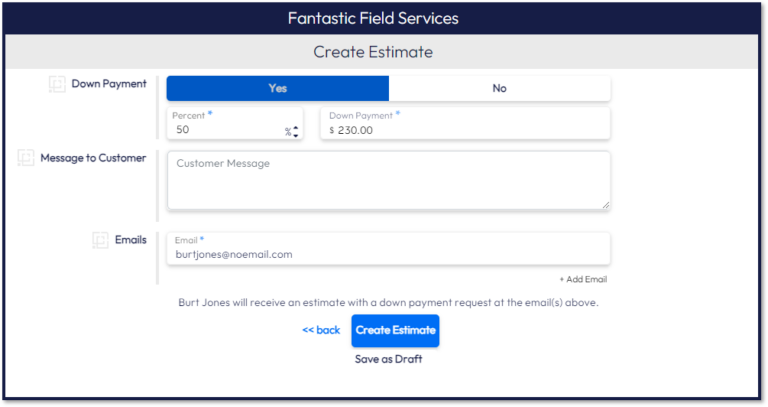When typical payment terms for contractors are not set, it can lead to delayed payments, or worse, no payment at all. If customers don’t know how and when to pay, they may wait until they receive a reminder from you. To ensure that you are paid on time, let’s discuss how to create an easy-to-understand payment agreement so you and your customers are clear on when and how payment is due.
What to include in payment terms
- Payment due date. This is a clear and concise way to tell your customers when you expect to be paid. On an invoice, this is typically written in net days. If an invoice says “Net 15 Days,” that means payment is due 15 days after the invoice date. Net 15 Days, Net 30 Days, or Net 45 Days are standard examples to state that you expect your customer to pay you within the established timeline or you will consider them late. If you are also requesting a down payment for your services, make sure to include how much the down payment will be and when you require payment.
- Payment methods. Let your customers know what types of payment you accept and how they can get the payment to you. The easiest and fastest way for your customers to pay is digitally or on the spot with their credit card. (Hint: Project 2 Payment can help you with that.)
- Late payment penalties. If you choose to charge a late payment penalty, provide details as to when and how much it would be charged.
- Refund policy. Having a refund policy, even if it’s “no refunds,” is typically required by most payment processors and lets your customers know upfront if they can request a refund.
- Contact information for customer questions. Don’t forget to give customers a way to contact you about payment-related questions. That way, if they run into any issues providing payment, you know about it right away.
Where to display your payment terms
- Project estimates. When you provide an estimate for a project, be sure to include your payment terms. Providing payment terms before you even begin a project ensures there are no surprises at the end of a project and that you get paid on time. Highlight if a down payment would be required, how much it would be, and when it’s due. Include when final payment for the project is required and how it can be paid.
- Project invoices. Once the work is completed, send the invoice immediately to your customer. Include in your message to your customer when you expect payment, and include written or linked payment terms on the invoice itself. This leaves no room for confusion regarding when payment is required.
- Your website. When researching different contractors, customers may also investigate how contractors take payment and when payment for work is required. This helps your customers understand what payment options they have and how to budget for projects, and it prepares them to be ready to pay when it is required.

Examples of typical payment terms for contractors
Typical payment terms for contractors don’t have to be complicated to be effective. For example, a very simple way to display payment terms would be: “Full payment is due upon the completion of the job (‘Due on Receipt’). Payment can be made by credit card or eCheck through our online payment terminal or with cash in person. No refunds. Please contact us at (insert contact details) with questions.“
If your projects are a little more complicated, or if you have a difficult time getting paid on time, here are more detailed sections of typical payment terms for contractors that you can add.
Down Payment: Upon agreeing to the project estimate, 50% of the total project estimate is required as a down payment to schedule work. After the project is completed, the final payment is Due on Receipt (or Net X Days).

Late Payment Fee: Failure to pay the final payment on time will result in a late payment fee of 1.5% of the project cost the first day payment is late and another 1.5% fee every 30 days after. An additional 1.5% late fee will be added every 30 days until full payment is made.
Future Services: In the event that a customer has past due invoices,(contractor) reserves the right to hold future services until payments become current even if services and timelines were already agreed upon.
Taxes: All applicable taxes must be paid with invoice.
Payment Options: Accepted forms of payment include credit card or eCheck through our online payment terminal or cash. Credit cards accepted include Visa, MasterCard, Discover, and American Express.
Payment Questions: Please contact our accounting manager, Ms. Cindy Snow, at 888-888-8888 or cindy@xyzcontractor.com.
Having a clear understanding of typical payment terms for contractors, creating ones that work for your business, and sharing your terms with customers will help clear up any payment misunderstandings and ensure that your business has a steady cash flow coming in. By getting customers to agree to your pricing and payment terms at the beginning of a project, you also help your business in those rare circumstances where you have to dispute a chargeback or file a lien against a customer who is not paying for your services.
It is in both your customers’ and your business’ best interests to have clearly stated payment terms on estimates, invoices, and your website. So, what are you waiting for? Get those payment terms up and added to customer-facing documents! Still not sure where to start? Project 2 Payment makes it easy to add your payment terms once and get them added to your estimates and invoices automatically. Ask our experts how it works.

